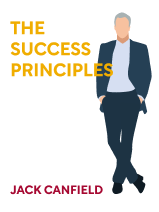

This article is an excerpt from the Shortform book guide to "The Success Principles" by Jack Canfield. Shortform has the world's best summaries and analyses of books you should be reading.
Like this article? Sign up for a free trial here .
What is the Law of Attraction? Do you believe that you can influence your life outcomes with your thoughts?
The Law of Attraction states that your thoughts can attract the things you want. It comes from the field of quantum mechanics, which says that two different particles can exhibit linked properties even if they’re on opposite sides of the universe.
Keep reading to learn how to use the law of attraction, explained with examples.
The Law of Attraction Can Help You Get What You Want
Here’s how it works: Almost everything is made up of energy-containing atoms that interact with one another to form materials and objects. Our thoughts register as brain waves on medical scanning equipment, which suggests that they’re also a form of energy and can interact with the universe around us. For example, if you think about needing to talk to your friend, only to get a call from them shortly thereafter, this is an example of your thoughts interacting with the universe and attracting what you want.
With this knowledge, we can train ourselves to think positively so that we channel energy to achieve what we want: If everything in the universe has a specific vibration, you can adjust your thoughts to match the frequency of the things you want and attract them into your life, similar to the way you’d tune a radio to the frequency of your favorite station.
One famous example of thought transmission was tested on the 1971 Apollo 14 mission. Edgar Mitchell sent a thought message to four people on earth, and three received the correct message—how to place a series of cards in the correct order.
How to Use the Law of Attraction
In his book The Success Principles, Jack Canfield explained the Law of Attraction in terms of two basic steps: 1) think positively, and 2) take action.
1) Think Positively
To achieve your dreams, think positively about what you want rather than focusing on what you lack or what isn’t going well. Each time you have a thought, you’re making a request to the universe about something you want. If you go through life thinking negatively, you’re placing negative requests with the universe and negative results will enter your life. Worrying is equivalent to negative goal-setting—by putting that negative energy into the universe, you’re willing your worry to happen. For example, if you’re constantly thinking about struggling to pay your mortgage, you may continue struggling to pay it.
Here are two techniques to hone a positive mindset:
1. Write affirmations. Affirmations are positive, present tense statements about something in your life or something you want. For example, say something like, “I am so happy to live in this beautiful house across the street from Dolores Park,” instead of, “I hope to someday live in a house across from Dolores Park.” By writing statements in the present tense and imagining how it’ll feel when you’ve achieved your desire, you’re placing yourself in the happy emotional state, or right vibration, necessary to achieve it. You’re also creating a mental gap between what you experience now and what you’d like to experience, which encourages you to take steps to close the gap. Principle 10: Expand Your Comfort Zone explores affirmations further.
2. Practice gratitude and appreciation. Practicing gratitude and appreciation will open you to making your dreams a reality. This is because if you had what you wanted, you’d—hopefully—feel gratitude and appreciation for having it. So, proactively cultivating these feelings will put you on the path toward getting what you want by attracting it into your life.
One way to practice this is taking five to 10 minutes each day to make a list of things you’re grateful for. Or look around and note things you appreciate. In his workshops, Canfield asks participants to take a walk around the meeting space and note the things they appreciate. Even something like the carpet can be appreciated for improving a room’s acoustics, and in addition to appreciating the carpet itself, you can appreciate things like the people who made it and the building designer who selected it for that space. This technique also works for people in your life: Focusing on why you appreciate someone can improve your relationship by giving weight to the qualities you like about them rather than what you dislike. You may find that the things you like outweigh the things you dislike, making your dislikes feel less relevant.
2) Take Action
Once you’ve developed a strong belief that you’ll get what you need, there are two types of action you can take to make it happen:
1. Obvious. An obvious action is any step you must take to achieve your goal. For example, if you want to become a nurse, you might select a school to do your studies and enroll in classes.
2. Instinctive. Listen to what your instincts tell you to do and take action. For example, you might have a gut feeling that you should attend a certain conference. Acting on your instincts and attending the conference could put you on the path to getting what you need and may present additional opportunities to do so. You also might get ideas for what to do through meditation or other activities; keep a pen and paper with you to jot them down so you can decide whether to act on them.
Example: Jeanette Maw worked for a bank that sold 401(k) plans to businesses. One day, the bank announced that they weren’t hitting their sales goals, despite each employee following a standard protocol for making sales. They were told they’d be let go if they didn’t increase their sales.
Jeanette had heard about a writing exercise where you write a page a day about something you want and by the time you get to the end of your notebook, you have it. She found a small notebook and wrote a page about having a friendly relationship with clients and people being excited about her service. Next, she decided to go out to lunch instead of just getting a snack from the vending machine between sales calls. On her way back, she met a man in the elevator who was trying to decide which 401(k) plan to buy for his company and wanted her bank’s services. By doing what felt right rather than following a rigid protocol, Jeannette began to quickly increase her sales.
Somatic decision-making can help you determine which ideas are worth acting on. Here are the steps:
- Stand with your eyes closed and your arms at your sides.
- Ask your body what right, or correct, looks like, and note the response. It’ll be your body leaning backward or forward.
- Ask your body what wrong, or incorrect, looks like, and note the response. If you naturally move in the opposite direction than you did for a good idea, then you know the two possible ways your body will respond to a question.
- Ask yourself basic questions you know the answers to, and note your body’s response. Questions might include, “Do I live in New York?,” or “Is my name Suzie?” This will help you determine whether your body’s responses are accurate.
- Test the ideas you’ve had, and note your response. Once you’re confident you’re receiving the correct signals, test out your own ideas with yes or no questions, such as, “Should I apply for that internship at the local university?” and “Should I go on a second date with Jeff?”
Note: If an idea comes up for you repeatedly, or you find yourself thinking about it frequently, that could be a sign you should act on it. For example, Canfield thought about starting an organization called the Transformational Leadership Council, but he didn’t take any action at first to make it a reality. When the idea continued to surface at seemingly random times, with even more specific details, like who he’d invite to join, he decided it was something he should pursue.

———End of Preview———
Like what you just read? Read the rest of the world's best book summary and analysis of Jack Canfield's "The Success Principles" at Shortform .
Here's what you'll find in our full The Success Principles summary :
- The 67 principles to help anyone achieve their goals and dreams
- Why achieving your goals requires you to invest your time and effort
- How to take responsibility for your own life






